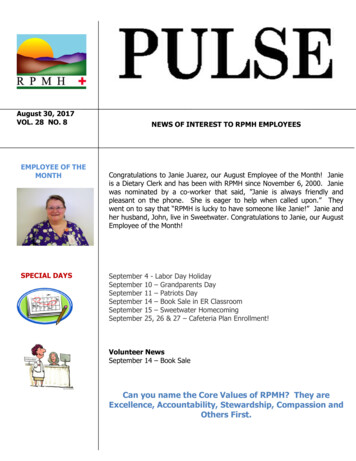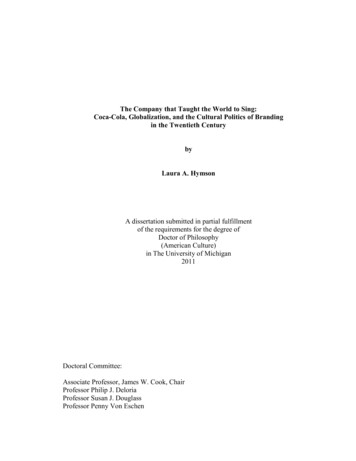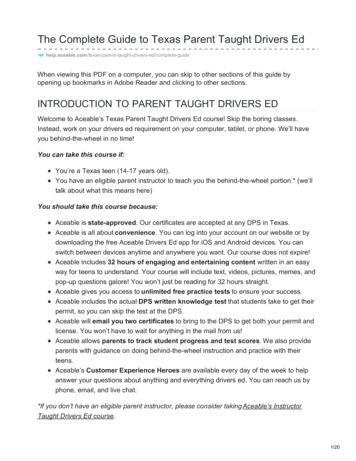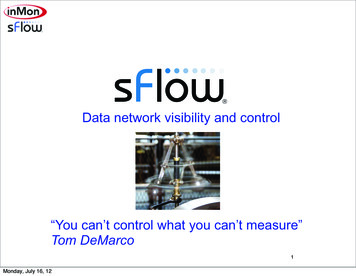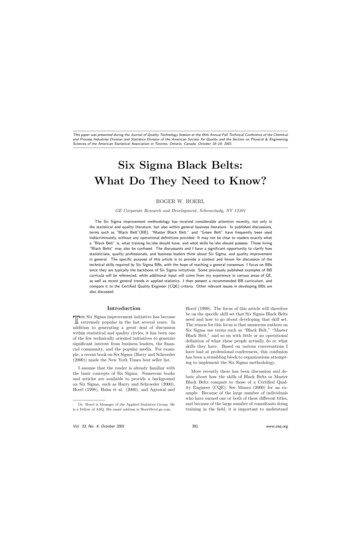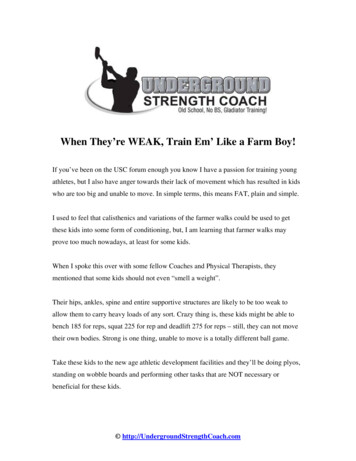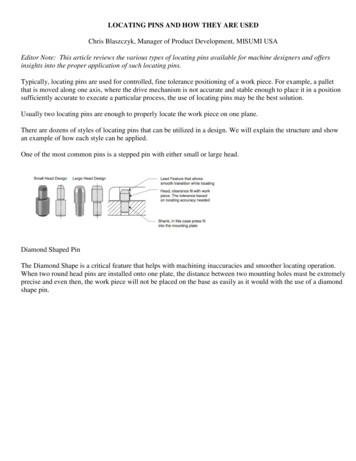
Transcription
THEY CAN BE TAUGHT!EMOTIONAL INTELLIGENCE SKILLSIN AT-RISK YOUTH (AND OTHERS)15TH IIRP WORLD CONFERENCEJENNIFER MURET BATECOMMUNITY LEARNING CENTERWINFIELD, KANSAS
What is Emotional Intelligence?What does it looklike?Who has it?
arithmeticreadingvocabulary general knowledge spacial imagery visualization perceptual speed reasoning induction visual/auditoryprocessing quantitative reasoning verbal comprehensionIntelligence Quotient (IQ)Cattell-Horn-Carroll theory
Crystalized Intelligence breadth & depth of acquired knowledge, ability tocommunicate knowledge, ability to reason usingpreviously learned experiences & proceduresFluid Intelligence reason, form concepts, solve problems using unfamiliarinformation or novel proceduresIntelligence Quotient (IQ)Thurstone theory
What makes a shining star?He is open-mindedShe can let things goShe can relate to a variety of peopleHe gets everyone else excited about the path we are takingShe handles negativity & disagreement wellShe recognizes effort in othersHe is willing to work as hard as anyone elseShe always focuses on, models ways to best meet people's needs
Emotional Intelligence (EQ)SelfAwarenessYour ability to recognize your own emotions, feelingsure about your own worth and abilitiesSelfRegulationYour ability to manage stress, stay honest, takeresponsibility for your performance & behavior, handlechange, be open to new ideasMotivationYour ability to constantly try to improve, align yourselfwith the goals of a group, be ready to act onopportunities, pursue goals persistently despite setbacksEmpathyManagerelationshipsYour ability to recognize how people feel, anticipateother's needs, work with many different types of people,understand why others act in certain waysYour ability to communicate clearly, influence & leadothers, cause positive change, manage conflicts, buildbonds with others by cooperating, create group identityGoleman, 1995
Importance of EQEmotional intelligence is the sine qua non of leadership. Without it,a person can have the best training in the world, an incisive,analytical mind, & an endless supply of smart ideas, but he stillwon’t make a great leader. Daniel Goleman in Harvard Business Review, 2004To make it in this environment, you’ll have to do something thatpeople overseas can’t do cheaper, that computers can’t dofaster, and that satisfies the growing aesthetic and emotional desiresof an abundant age.Daniel H. Pink in Journal of New England Board of Higher Education, 2005
Personality factors and emotional intelligence have importantroles in contributing to good psychological health foradolescentsSamuel O. Salami in Social Behavior & Personality, 2011Moods and emotions increase flexibility in future planning andproblem solving, support inventive thinking, direct or re-directattention, and motivate & sustain persistence at challenging tasks.Given these circumstances, it becomes even more critical toincorporate the teaching of emotional competency.Jill Aguilar, Dani Bedau, & Chris Anthony in Reclaiming Children & Youth, 2009
Costs of Emotional ictionBullyingJob FailureDroppingOutEatingDisordersGoleman, 1995
The good news.they can be taught!Goleman found that,unlike IQ , emotionalintelligence can belearned and increased.
Community Learning CenterEQ Project 12 week teaching unit (activity period)Sept - Nov 2011 Students given multiple "pre-test"assessments Students organized into small & largegroups for lessons & activities relating toGoleman's five areas of EQ Students given corresponding "post-test"assessments and a narrative finalevaluation of the unit
Self-awareness activities personality & working style inventories self-esteem quiz right-brain/left-brain survey feelings & emotions recognition activities
Self-regulation activities turning complaints intorequests stress management activity lessons managing shame,reframing negative thoughts writing advice column letters
Motivation activities "SMART" Goal lesson monthly goal-settingactivities & monitoring ofprogress "graveyard" pictures putting negative past events"to rest"& moving on daily check-in & check-outcircles
Empathy activities circle discussion: what is empathy two sides to every story activity (drawings: "icebergs") sharing reactions to pictures activity movie: discuss character's feelings & overall EQ
Managing relationshipsactivities activity: how to givefeedback positive feedback circles activity: turningcomplaints into requests activity: conflictmanagement styles
Our Results: self esteem survey107.552.50high (60-75)moderate (45-59)pretest mean 57.4low (0-44)post-test mean 58.3
Our Results: online EQ assessment107.552.50extremely highvery high(55-60)(45-54)pretest mean 40.0slightly above ave slightly below ave(35-44)(25-34)post-test mean 40.6
Our Results: paper EQ assessment43210excep high(55-64)very high(45-54)high(37-44)pretest mean 36.4above ave(29-32)well above ave(33-36)ave(25-28)below ave(21-24)post-test mean 39.2
Conflict Narrative Results(pretest)Total Responses: 19(most synonyms for "angry")Recommendations:"they should grow up""stop being annoying""ignore the other person""call the police"67% believed the conflict could be solved
Conflict Narrative Results(post-test)Total Responses: 43(less than half synonyms for "angry")Recommendations:"talk to the other person""find out why she is upset""think about what he feels""be more understanding"82% believed the conflict could be solved
Students' Final Evaluations handling conflict has improved in theschool we see changes in self-control, getting along,awareness of others, & communication people are more polite & understanding &have better attitudes school climate has calmed down; it's morecomfortable peaceful, friendly &productive we use EQ skills outside of school: less fightingwith friends, more thinking before acting,listening to others, & speaking outabout problems
Staff's Final Evaluations students self-regulate more easily & stop themselves when upsetto assess situation instead of blowing up students more able to recognize & communicate their emotions school climate positively affected with students' improvedabilities to manage stress & conflict students more able to be civil, even when they are disagreeing students talking more about their feelings, having more empathy& less conflict
Conclusions Students and staff have learned to be more reflective, openminded, honest with ourselves and others, and tolerant, whichmay be the most important things a person can learn. Community Learning Center plans to continue to incorporateEmotional Intelligence instruction with its academic curriculum.
ReferencesAguilar, J., Bedau, D., & Anthony, C. (2009). Growing emotional intelligence throughcommunity-based arts. Reclaiming Children & Youth, 18, 3-7.Goleman, D. (1995). Emotional Intelligence: Why it can matter more than IQ. New York:Bantam.Goleman, D. (2004). What makes a leader? Harvard Business Review.Kane,H. & Brand, C. (2003). The importance of Spearman's g as a psychometric, social &educational construct. Occidental Quarterly, 3(1).Salami, S. (2011). Personality and Psychological Well-being of adolescents: The moderating roleof emotional intelligence. Social Behavior and Personality, 39(6), 785-794.Pink D. (2005). The coming right brain economy. Journal of New England Board of HigherEducation, XX(1).
Turning Complaints into Requests"I don't haveanything to writewith!""It's hot in here!"vs."Can I borrow apencil?"vs."Will you please openthe window?"
jmurbate@cox.net
MaterialsPacket
Online ResourcesAssessments:Self-esteem passessment.htmlEQ assessment:http://www.ihhp.com/quiz.phpEQ assessment:psychology.about.com/library/quiz/bl eq quiz.htmEmotions label:greatergood.berkeley.edu/ei quiz/Activities:http://helpguide.org/mental/eq5 raising emotional mended Reading:Bradberry, T. & Greaves, J. (2009). Emotional intelligence 2.0. San Diego, CA:Talentsmart.Carter, P. (2009). Test your emotional intelligence. Philadelphia, PA: KoganPage.Daniel, M. (2000). Self-scoring emotional intelligence tests. New York, NY: Sterling.Goleman, D. (1995). Emotional intelligence: Why it can matter more than IQ. New York,NY: Bantam.Lynn, A. (2007). Quick emotional intelligence activities for busy managers. New York,NY: Amacom.Self Awareness Activities1. Using "Emotions Faces" handouts (these & otheractivities are available at www.kk107.k12.sd.us/new page 2.htm),
compete a feelings-check circle, encouraging participants to identify precisely how theyare feeling.2. Create a chart using "Emotions Faces" or the "Six Families of Emotion" handout (lesson EQ1, available in Quick Emotional Intelligence Activities for Busy Managers). Giveparticipants colored sticky dots and have them stick the dots on the chart to indicatetheir feelings. (This can be done over multiple days, to compare differences in moodover time.) Discuss how our feelings at a given time affect our perceptions of people& events and how feelings can be "contagious" to others.3. Have participants compete left brain/right brain surveys (available atwww.homeworktips.about.com/library/brainquiz/bl leftrightbrain quiz.htm). Read"advice" given for your type. Read the characteristics listed there and discuss whetheryou feel they accurately reflect you. Choose 2-3 pieces of advice to try to implement inthe coming week; then discuss your experiences with the group.4. Have participants complete the True Colors personality quiz (available atwww.truecolorscareer.com). Read the description of your personality type and make acollage that represents your personality traits and talents. Share your collage with thegroup and discuss.5. Using results from the online surveys, create pictures, charts, or diagrams ofparticipants' personality or brain"types." Discuss the benefits and difficulties ofworking in teams of those who are like or unlike you. (For extra credit, create teamswith differing "types" and complete a task - such as building a bridge out of notecards.Give teams limited supplies and time to meet specific requirements for the task - suchas height, strength, design, etc. When task is complete, discuss the process ofcompleting the task and how having the different "types" of team members affectedthe process. Predict how it what would happen with teams of similar "types.")Self Regulation Activities1. Create a poster showing three aspects of stress. The left column represents issues,problems, situations, etc., which you find stressful. The center column representsyour (physical,emotional, behavioral, etc.) responses to stress. The right columnrepresents ways in which you reduce or deal with stress.Prior to creating your poster you may spend time in circles discussing these threeaspects. Posters may utilize pictures, drawings, or words, and may be shared withthe group or posted upon completion.
2. Using the four points of Nathanson's Compass of Shame (withdrawal, avoidance,attack self, attack others), create a diagram on the floor. Then ask participants tothink of a time in life that was difficult, remember how they were affected, and howthey reacted. Without necessarily sharing the nature of the difficulty, ask participantsto stand within the diagram and walk to the four points which represent theirreactions, sharing as much detail asthey are comfortable discussing.When all participants have had an opportunity to share, note what appeared to beshared experiences. Discuss possible problems that could occur if the reactions weretaken to extreme, & what could help avoid those problems.3. Discuss with participants our tendencies to assume the best of ourselves & theworst of others in conflict situations. Think about the impact our actions may have onwhether a situation escalates or de-escalates. Using examples of conflict fromeveryday life, fill out the following chart: (an example has been included)EventImportant papers you left on the table are missingNegative ThoughtThe person sitting at the table stole themMy ActionI angrily accuse him/her of theftLikely ResultWe get into an argument, & possibly a fightReframed, Positive ThoughtSomeone might have accidentally picked them up,or I might have lost themI ask the person at the table if he/she could help meMy Action
Likely Resultlook around for themWe search together, & might find the papers; won'tlikely get in a fightDiscuss with participants that it is sometimes beneficial to give others the benefit ofthe doubt, and that we can "choose our own adventure" by determining how we reactin a conflict situation. Challenge participants to try this in real life, & report theirresults back to the group.4. Using situations common to your participants (depending on age, setting, etc.),imagine a person with a problem has come to them for advice. Participants may roleplay the situation, write a "Dear Abby" style advice letter, or simply discuss what theywould recommend to the person. (An example follows:)Dear Wise Participants,I have had a lot of trouble recently with an acquaintance. He/She has been saying reallynegative things about me to my friends. This person just stares at me whenever we are in thesame room. I don't remember doing anything to him/her, so I don't have any idea what this isabout. It makes me really uncomfortable. I don't know what to do about it, and I don't wantthings to get worse. What should I do?Motivation Activities1. Introduce participants to the concept of SMART goals (that are Specific,Measurable, Action-oriented, Reasonable, & Time-bound). Examine somecommon goals people have (ie, New Year's resolutions), and discuss whether theyare SMART. If not SMART, re-word the goals, adding details so that a personmight be accountable & know whether the goal had really been achieved.Example: I want to get organizedRe-wording: I will file the pile of papers on the desk by Friday afternoon.(more information available athttp://www.tlplearningsolutions.com/docs/SMART Goals Teens 2011.pdf)2. Ask participants to spend 2-3 minutes brainstorming goals (both personal andprofessional/academic) they have for themselves. Then, ask participants to choose 2 4 goals they would like to work on this week/month/quarter. Have participants answerthe following questions (& consider posting the information in a place participantswill be able to be reminded of their answers): What is your goal? (be sure to state in SMART goal form) Why is this goal important to you? What steps should you take to achieve the goal? When (specifically) will you takethese steps?
What help or resources to you need to take these steps to reach your goal? How &when will you do that? What benefits/rewards will occur as a result of achieving your goal?3. Conduct regular check-in circles with participants in which you discuss your goals.Discuss your progress, milestones & successes, set-backs, questions, frustrations, andany changes you might have made to your goals. Provide an opportunity to ask forinput and assistance when needed. Affirm each other's hard work, and providesupport as well as accountability.4. Ask participants to think about past problems, events, associations, or difficultiesthat made it hard to achieve their goals, make good decisions, and become their bestselves. Ask participants to decorate "gravestones" or write epitaphs and symbolically"put to rest" these negative influences. (RIP: Procrastination)Empathy Activities1. Reading: "What's Empathy Got to Do With It?" (B. Martinuzzi, 2006; available:www.mindtools.com/pages/article/newLDR 75htm) Discuss the ten tips fordeveloping empathy:Trulylisten to people Don't interrupt people Tune-in to others' non-verbal communication Pay attention to your own non-verbal communication Use people's names Be fully present when you are with people Smile at people Encourage people to speak Give genuine recognition & praise Take a personal interest in people2. Show participants the following pictures (available ble-meaning/optical-illusionsdouble-meaning.php). Ask them to remain silent, but examine the picture and writedown what the picture shows. After giving participants time to do so, ask for everyoneto share answers. Discusswhyanswersaredifferent,
and what that might teach us.portrait of a man's bust,picture of a woman's face,drawing of a youngor 2 people on the street?or a saxaphone player?woman, or old woman?3. Show participants a series of pictures (collected from magazines, newspapers,online, etc.) and ask them to list 2-3 words that describe how they feel when looking ateach picture. (Examples might include the ocean, bungee jumpers, a playground, apolice officer, horses, etc.) After writing their reactions for all the pictures, askparticipants to share their answers for picture #1. Note the difference in people'sanswers. Discuss why we might have different reactions, and that each one's reactionis equally valid. Note the importance of making ourselves aware of other people'sfeelings.4. Behavior icebergs: Discuss with participants that our behaviors are like icebergs;only a small part of the total is visible to others. More information available 0Emotions%20Workshop.doc)At a given time, people can see our actions, but they cannot (unless we make a pointof sharing them) see our thoughts, motives, attitudes, feelings, or values which mighthave led us to those actions. They only know part of the story, and often this causesproblems and misunderstandings between people.Using the diagram of the iceberg, ask participants to think of a time their behaviorswere misunderstood. Fill in the "seen" and "unseen" parts of the iceberg with detailsfrom that time. Discuss what it was like to be misunderstood, and what problemsresulted. (Extra credit: do the exercise again, this time asking participants to think ofa time another person "wronged" them. Ask participants to put themselves in theother person's shoes, and imagine what "unseen" factors might have been at work atthe time. Discuss how participants' feelings about the wrongdoing might have beenimpacted if they had known these "unseen" factors, and whether their own reactionsmight have been different.)
Discuss the potential value in sharing the "unseen" parts of our iceberg behaviors, andin remembering that all people have a lot more "below the surface" than wecommonly know.ouractionsour valuesour motivesour feelingsour attitudesour thoughtsI didn't go to mybest friend's birthday partyI knew her other friend (that Idon't like) would be thereI didn't want to start a fightI wanted my friend's birthdayto be niceI was sorry to miss, but her daybeing nice is more importantChris yelled at mein front of a group of people?5. Show participants a clip, TV show episode, or movie .(Depending on setting & ageof participants, you might use The Office, Peanut's Thanksgiving special, The FreedomWriters Diary, etc.) After viewing, discuss with participants some of the following: How much empathy did the character(s) show? What "unseen" factors may have been influencing the character's behavior? What recommendations would you make to the characters to help improve theirempathy skills? (Or, if their skills were good, what specific examples of empathy didyou notice the characters show?)
How might this story have been different if the characters had significantly better (orworse) empathy skills?Managing Relationships Activities1. Discuss with participants how to receive feedback (listen with an open mind,acknowledge the speaker, don't explain, agree or disagree). Then conduct a seriesof circles:Positive feedback circle: Moving around the circle, have participants each tellsomething they appreciate or admire about the person on their right. When the circleis complete, repeat the process going the other direction, with participants tellingsomething they appreciate or admire about the person on their left. (Alternate format:choose one person to be the subject of the circle, and have all other participants in thecircle take turns telling something they appreciate or admire about that person.)2. Turning complaints into requests: Ask participants to make a list of things that arebothering them at this point in time. (Lists can include simple or serious issues.)Then ask participants to choose one item from the list to share with the group. Goaround, giving each participant a chance to read his/her issue.Discuss that how we communicate our issues with others has a direct impact on thelikelihood they will be willing to help resolve the issues. For example, "I don't haveanything to write with; there are no pencils in this room," is not likely to make anyonevery sympathetic to us. (It seems whiney and obnoxious.) Instead, we should thinkabout what it is that we really need - a pencil - and make a request. For example,"Could someone lend me a pencil?"Ask participants to practice turning the complaints they shared with the group intorequests. Then share the requests with the group. Compare the likely reactions whenissues are shared as requests instead of complaints. (Extra credit: throw in a "please.")Examples:"My stuff is all over the place." could become"Please put my things back after you use them." or"Could someone help me straighten things up?" or"Could I borrow a bag to put my things in?"3. Conflict Resolution Techniques: Ask participants to brainstorm a list of conflictsthey remember encountering. Ask them to discuss how those conflicts were (orweren't) resolved. What did they (and the others involved) do? How well did it work?
What were the issues involved? Did they get what they wanted? Did they get all ofwhat they wanted, or just part? Were there any consequences or collateral damage?Discuss with participants that there are many different ways to resolve conflict. Theseinclude competition, collaboration, compromise, accommodation, and avoidance.Stress that none of these techniques is the single best way to resolve a conflict, but thetechnique you choose should be based on the particular conflict situation. Factorsinfluencing your choice include the relative importance of the problem, how quickly itneeds to be addressed, and the importance of the relationship with others involved inthe struggle. (More information available )Ask participants to discuss the potential benefits and drawbacks of each conflictresolution technique. Have participants relate back to the conflict they discussed withthe group and identify which technique(s) were used to resolve the conflict. Discusswhich other techniques might have been helpful in the situation and how they mighthave been implemented. (Encourage application of these techniques in following daysin real-life conflicts, including reporting back to the group on the experience.)4. Applied Conflict Resolution Techniques: Ask participants to find stories ofconflicts in the news. Have participants report back what techniques were used andevaluate the results. Have participants make recommendations based on theirknowledge of conflict resolution techniques.
EQ Project 12 week teaching unit (activity period) Sept - Nov 2011 Students given multiple "pre-test" assessments Students organized into small & large groups for lessons & activities relating to Goleman's five areas of EQ Students given corresponding "post-test
